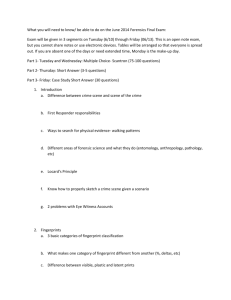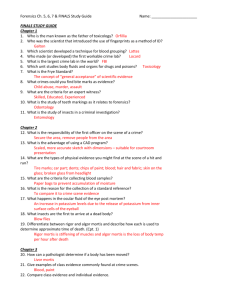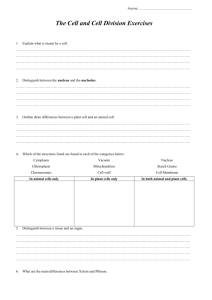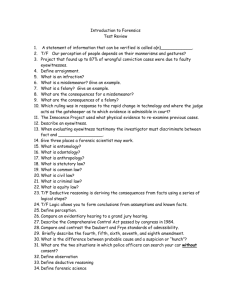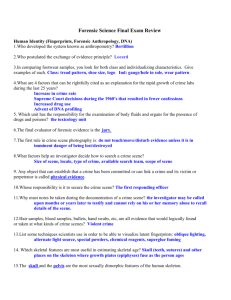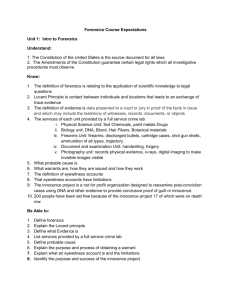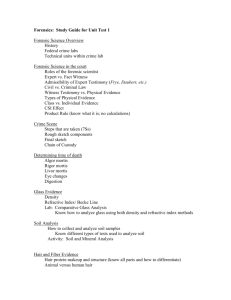Review for Forensics Final 2005
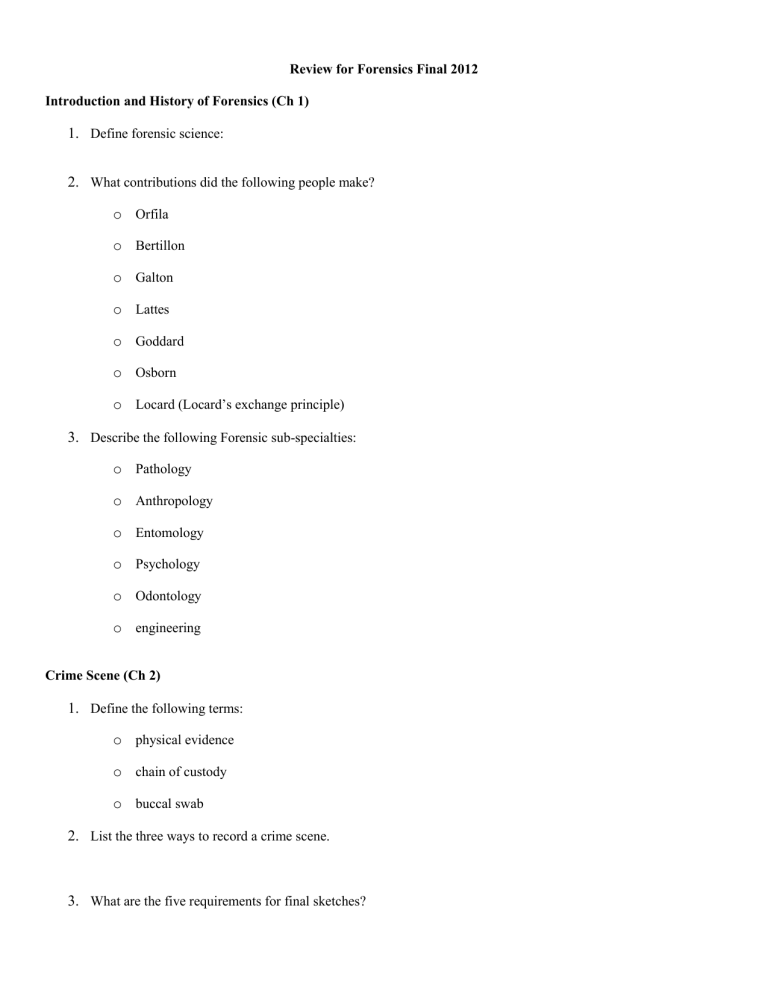
Review for Forensics Final 2012
Introduction and History of Forensics (Ch 1)
1.
Define forensic science:
2.
What contributions did the following people make? o Orfila o
Bertillon o
Galton o
Lattes o
Goddard o
Osborn o Locard (Locard’s exchange principle)
3.
Describe the following Forensic sub-specialties: o Pathology o Anthropology o Entomology o
Psychology o
Odontology o engineering
Crime Scene (Ch 2)
1.
Define the following terms: o physical evidence o chain of custody o buccal swab
2.
List the three ways to record a crime scene.
3.
What are the five requirements for final sketches?
4.
List and describe (or draw) the four crime scene search patterns.
5.
Define and explain what the purpose of a control is.
6.
In order, list 7 steps involved in processing crime scene.
7.
What is the “chain of custody” and why is it important to maintain during a crime scene investigation?
Physical Evidence (Ch 3)
1.
Define physical evidence and provide examples
2.
Distinguish between the processes of identification and comparison. Provide an example of each.
Glass (Ch 4)
1.
Distinguish between radial and concentric fractures. Draw a picture and label it.
2.
Describe how you determine the order that projectiles penetrated glass by analyzing the fracture patterns?
3.
Describe how you determine the direction that projectiles were traveling by analyzing the fracture patterns?
4.
Describe how density is used to analyze glass samples.
5.
Describe how refractive index is used to analyze glass samples? What is meant by the match point? When is a piece of glass visible in a liquid? When is it “invisible”?
Hairs and Fibers (Ch 8)
1.
Draw a picture of a hair. Label the following structures: cuticle, cortex, medulla, tip, root, follicle
2.
Distinguish between the three phases of hair growth: o anagen o catagen o telogen
3.
Which of the following can be determined by examining hair? Explain.
o
Species o
Forcibly pulled vs shed o
Age o
Sex o Race o
Drug use/Nutritional deficiencies
4.
What part of the hair can DNA be extracted from?
5.
Describe how easy or hard the following steps of hair analysis are: o
Identification (ie, determining the type of hair)
o Comparision (ie, determining if a suspect’s hair matches a CS sample)
6.
Describe how the structure of the cuticle and medulla differ between animals and humans.
7.
Define and provide examples of the following types of fibers o natural fibers o synthetic fibers
8.
Sketch and describe the differences between cotton, nylon, linen, rayon and wool fibers
9.
Describe how plain, twill and knit weave patterns look different from one another.
Forensic Serology and Analysis of Blood Spatter (Ch 12)
1.
Define the following terms: o
Antibody o
Antigen o
Antiserum o
Agglutination o
Codominance
2.
Describe the components of blood. What parts make up the liquid part? What parts make up the cellular part?
3.
What is the difference between plasma and serum?
4.
Describe the basis for the ABO and Rh blood typing systems. How do the blood type, type of antigens and type of antibodies relate to each other? Provide examples to illustrate you point.
5.
How does a person’s blood type dictate what types they can donate to or receive from? Provide examples to illustrate your point.
6.
Use Punnet Squares to practice genetics problems: o
If a type A woman and a type B man have children, what blood types could their children have? o
What possible parental blood types could a child with type O have? Type AB?
7.
What is the probability of having type A+, M blood? What about type B-, S? Report your results as number of people and %.
8.
How can you determine if a red substance is blood? Provide examples and descriptions of the tests performed.
9.
How can you determine if blood is of human or animal origin? Provide examples and descriptions of the tests performed.
10.
How can you determine if a suspect’s blood sample matches a crime scene sample? Provide examples and descriptions of the tests performed.
11.
How do the following factors influence the size and/or shape of blood stains? Draw pictures if it helps.
o target surface – rough vs. smooth; absorbent vs. not o height of fall o impact angle o direction of travel
12.
What methods are used for determining the point of origin and impact angle of blood spatter patterns? Draw pictures to help explain.
13.
What is the difference between a swipe and a wipe?
DNA Fingerprinting (Ch 13)
1.
Define/distinguish between the following terms: o
Genotype vs. phenotype o
Homozygous vs. Heterozygous o
Gene vs allele o
Dominant vs. recessive o introns vs exons o coding vs noncoding DNA o amount of variation among people for each type of DNA
2.
Which type of DNA is more similar between humans- coding or noncoding? Which type is analyzed in DNA fingerprinting?
3.
What is the difference between RFLP analysis and STR analysis? Include acronyms, types of DNA repeats analyzed, methods and uses.
4.
What does CODIS stand for? What is its purpose and what does it allow forensic scientists to do?
5.
Describe the following about Mitochondrial DNA- how it is used, how it is inherited, advantages/disadvantages as compared with nuclear DNA for CSI purposes
6.
How many locations in the genome must be examined to demonstrate a “match”? (Not necessarily a number but the concept)
7.
How should biological evidence be stored and why?
8.
What is the probability that two individuals will match at the D8, D5 and vWA loci? Report your answer as both a percent and the number of people.
9.
How are gels analyzed differently for paternity vs. criminal cases? Which bands are expected to match/not match?
Handwriting Analysis
1.
List the 12 points of handwriting analysis
2.
Which features of handwriting never change? Which do? Provide an example of avariable and a nonvariable feature.
3.
Describe how chromatography works and how it is used to analyze handwriting
Fingerprints (Ch 14)
1.
What are the 3 principles of fingerprinting?
2.
Sketch the 6 different minutiae/ridge characteristics
3.
Distinguish between latent, visible, and plastic prints
4.
How can you distinguish between the major classes of fingerprints: loop, whorl, arch- and types of each? Draw a sketch to help.
5.
How do you calculate the primary identification number?
6.
How does AFIS work and is it able to completely replace trained fingerprint examiners?
7.
Describe the methods of developing prints (including what they adhere to) and types of surfaces used for each
(porous/non-porous): powders, iodine, superglue, ninhydrin, silver nitrate
Analysis of Drugs and Poisons (Ch 9, 5)
1.
How has the rise in crime has impacted the work that crime labs do? What percent of crime cases involve drugs?
2.
Distinguish between physical vs. psychological dependence
3.
Define and provide examples of the following: o
Narcotics o
Hallucinogens o
Depressants o
Stimulants o
Anabolic steroids
4.
Describe the basis for the drug schedules. (I versus V; medical value, addiction/abuse potential)
5.
What is the difference between screening and confirmation tests? Provide examples of each.
6.
Describe the technique and the purpose for the following tests: color tests, microcrystalline tests, chromatography, spectrophotometry (IR, mass), microscopic analysis of plant material, GS/MS
7.
Describe the technique of chromatography. What are the two phases involved and how do they interact with each other? What is the formula for R f
calculations?
Forensic Pathology
1.
Define, describe or distinguish between the following: o
Autopsy
o types of incisions made o purpose of external vs. internal exam
2.
How are various organs and hair inspected? What are pathologists specifically looking for?
3.
What are the functions of the medical examiner?
4.
List and explain the different manners of death.
5.
What is the difference between a medical examiner and a coroner? How does their training differ?
6.
Define the following: For each provide a brief timeline and describe the factors that affect them. o
Livor mortis o
Rigor mortis o
Algor mortis
7.
Briefly describe the types of decomposition of the body and when they occur.


